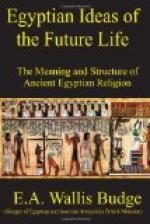and they immediately acquainting the people with the
news gave the first occasion to the name Panic Terrors,
which has ever since been made use of to signify
any sudden affright or amazement of a multitude.
As to Isis, as soon as the report reached her she
immediately cut off one of the locks of her hair,
[Footnote: The hair cut off as a sign of mourning
was usually laid in the tomb of the dead.] and put
on mourning apparel upon the very spot where she then
happened to be, which accordingly from this accident
has ever since been called Koptis, or the city
of mourning, though some are of opinion that
this word rather signifies deprivation.
After this she wandered everywhere about the country
full of disquietude and perplexity in search, of
the chest, inquiring of every person she met with,
even, of some children whom she chanced to see, whether
they knew what was become of it. Now it happened
that these children had seen what Typho’s
accomplices had done with the body, and accordingly
acquainted her by what mouth of the Nile it had been
conveyed into the sea—For this reason
therefore the Egyptians look upon children as endued
with a kind of faculty of divining, and in consequence
of this notion are very curious in observing the
accidental prattle which they have with one another
whilst they are at play (especially if it be in a
sacred place), forming omens and presages from it—Isis,
during this interval, having been informed that
Osiris, deceived by her sister Nepthys who was in
love with him, had unwittingly united with her instead
of herself, as she concluded from the melilot-garland,
[Footnote: i.e., a wreath of clover.]
which he had left with her, made it her business
likewise to search out the child, the fruit of this
unlawful commerce (for her sister, dreading the anger
of her husband Typho, had exposed it as soon as
it was born), and accordingly, after much pains
and difficulty, by means of some dogs that conducted
her to the place where it was, she found it and bred
it up; so that in process of time it became her
constant guard and attendant, and from hence obtained
the name of Anubis, being thought to watch and guard
the gods, as dogs do mankind.
“At length she receives more particular news of the chest, that it had been carried by the waves of the sea to the coast of Byblos, [Footnote: Not the Byblos of Syria (Jebel) but the papyrus swamps of the Delta.] and there gently lodged in the branches of a bush of Tamarisk, which, in a short time, had shot up into a large and beautiful tree, growing round the chest and enclosing it on every side, so that it was not to be seen; and farther, that the king of the country, amazed at its unusual size, had cut the tree down, and made that part of the trunk wherein the chest was concealed, a pillar to support; the roof of his house. These things, say they, being made known to Isis in an extraordinary manner by the report of Demons, sue immediately




